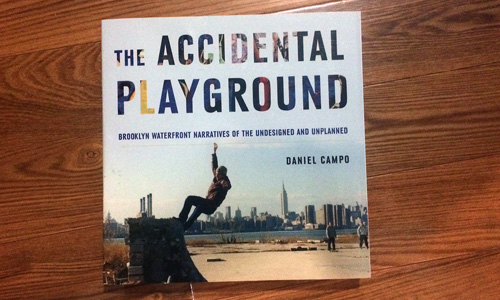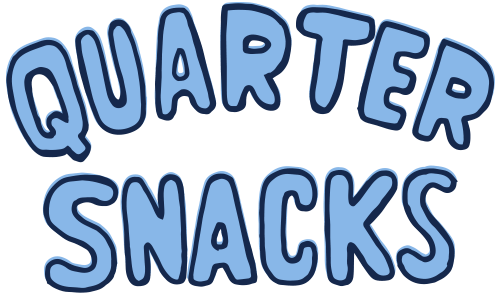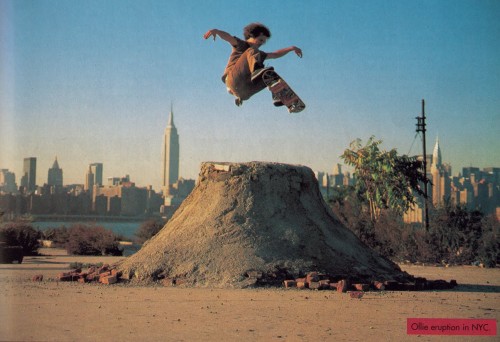
As D.I.Y. spots have become more common over the past decade, the Brooklyn Volcano remains an anomaly. It was the first New York spot of its kind, and existed in a place that could have hypothetically grown into something the size of a skatepark. Given the route real estate has taken throughout the Bloomberg years, it will likely be the last of its sort. New York D.I.Y. spots are now one-offs in spaces that could not accommodate a full, skater-made skatepark.
Daniel Campo’s The Accidental Playground is a case study of the Brooklyn Eastern District Terminal (BEDT), a onetime freight loading yard. The BEDT was home to the Volcano, a photogenic D.I.Y. spot overlooking the Manhattan skyline, seen in any skate magazine from the early 2000s. Campo is a former New York city planner and an architecture professor at Morgan State University. He is an advocate of “unplanned” public space, and writes The Accidental Playground to discuss the merits of when cities do not get involved with the recreational lives of their citizens, allowing them to “make their own environment.” These sort of spaces present a “get your hands dirty” alternative to the “manicured” nature of a Central or Prospect Park.
Compared to the restrictions faced in official parks, the BEDT was practically lawless within reason. Recreational use of the space was pioneered by dog walkers fed up with leash laws, but eventually gave way to a range of characters with interests that were not accommodated by other nearby parks. This included artists, a punk marching band, undocumented day laborers who could not procure on-the-books housing, and neighborhood residents who wanted to drink a beer outside without worry of an open container ticket. Campo considers skateboarding to have been the most sophisticated use of the space, though each group is afforded its own chapter in the book.
The most recognizable photo of this place, shot by Patrick O’Dell. This is obviously not in the book. There are some pages of glossy color photos, but the images in The Accidental Playground are candid and far from professional skate photography.
Campo is not a skateboarder. His writing is academic, and you could imagine much of his audience being students of architecture, so there are many instances in which he describes various surface-level skateboarding concepts. He does, however, share the same frustrations we face when we put our boards down in any public space. In reading his book, you understand that skateboarding is not vilified solely because of property damage concerns.
A cloud of perceived risk hangs over much of the activities that flourished at the BEDT. American city plazas are structured to a point where the slightest chance of a breakdown in order (i.e. a lawsuit) must be eradicated in their design, and this extends far beyond skateboarding. Campo brings up how more cognitively challenging playgrounds have been unable to flourish in America, despite the advice of developmental psychologists, and how parks are often designed with a mistrust for its patrons being able to come in contact with a natural body of water. A recurring theme throughout the book is that all of these things are inconsistent with European cities. Our country’s sue-happy identity hinders the ability to skateboard, drink a beverage with 4% alcohol content, or even touch natural water in most public spaces. Campo’s study plunges you into a red tape strewn hole of bureaucratic irrationality.
The most Volcano-heavy montage of the early-2000s, released right after it was torn down.
The Volcano portion of The Accidental Playground is examined under the shadow of Owl’s Head Skatepark, the first true concrete park in New York, which had opened in the summer of 2001. Owl’s Head was plagued by issues of opening hours, overcrowding and other rules, while the regulation-lacking Volcano remained problem free. Soon after, what had started as debris and turned into a skatepark, was reversed back into a pile of rubble. The city tore down the Volcano by the end of the summer, despite no immediate plans for other use of the space. It was not supposed to be there and that was reason-enough. “You know there’s a skatepark around here, right?”
It is interesting to read Campo’s case with knowledge of the Save Southbank campaign. Southbank was once a swath of neglected public space that turned into an icon for an entire culture. It eventually gentrified, and now, the people who did not make the mistake of neglecting it for three decades, are being presented as unreasonable for not wanting to be bought off with a skatepark. At its best, The Accidental Playground is a scholarly voice saying we are not wrong by insisting a skatepark does not replace an “accidental” space fostered to an unintended function. All we want is somewhere to be left the fuck alone. Or as Campo would more gently put it, a space “without fixed function or fixed schedule.”
The Accidental Playground is more textbook than coffee table book (it is nearly 300 pages.) If you need some winter reading, don’t let that deter you: scoop it up on Amazon. You may not read all of the sections, but there are a lot of good bits in there. For more D.I.Y. skate spot books, also check out the more coffee table-esque D.I.Y. by Richard Gilligan (reviewed on QS this past spring.)







LEO SOTY LEO SOTY LEO SOTY LEO SOTY LEO SOTY LEO SOTY LEO SOTY LEO SOTY LEO SOTY LEO SOTY LEO SOTY LEO SOTY LEO SOTY LEO SOTY LEO SOTY LEO SOTY
Anyone remember which vid had that DVD bonus section with the volcano footage? Thinking it might have been Brick & Mortar?
Fuck a Amazon.com
Support your local bookstore,
Fucking top notch review. Grabbing this asap.
It’s funny (read: sad) that the intro to Richard Gilligan’s DIY book is by Ian Borden who is one of the leaders in tearing down southbank and building a sanctioned skatepark. He is also in the small group of scholarly skaters out there that writes well about skating. So basically, and bizarrely, if you wanted to make some sort of academic case regarding the need for unsanctioned places to skate, you’d probably be quoting him at some point.
incorrect jules. ian borden has been very vocal about his wishes to keep the undercroft as it is. that said, he looks at the argument objectively and as an impartial third party. remove your desire to skate at southbank and look at the scenario with a fresh pair of eyes. there are pros and cons to removing/keeping the site as it is on both sides.
Hey Lavar- It’s difficult for me to make a logical bridge from this, http://www.youtube.com/watch?v=EMQwktfjeTA to this, http://www.youtube.com/watch?v=NcAymf0Oh5Q That said, I don’t live there, I’m not privy to the politics of the situation, and I know that savesouthbank has a difficult chance to achieve victory with an all-or-nothing stance. I guess what’s interesting in the whole thing here and in general with current skatepark politics is that increasingly it is being revealed that a good place to skate isn’t necessarily a collection of well made ledges and ramps. What that is and how to cultivate it I’m not sure, so take these message board ramblings with a grain of salt.
fuuuuuck, at least you have fucking professors that write books about skateboarding. I can’t get my dad to take this shit seriously, nevertheless my damn lit. profs.
yeah fair enough. i concede that he is developing the ideas (now finalised, apparently) for the new site at the spot formerly known as pigeon shit banks (r.i.p. sort of) and its not great to find out that hes been working on that. in his defense though he is looking at the whole scenario with the interests of someone who wishes to keep skating at the southbank in one form or another. Although i skate at southbank most days i can and have done for the last 10 odd years, im getting abit worn down by the whole thing to be honest. maybe i am beginning to show a defeatist attitude but i’m aware that a spot is just a spot at the end of the day.
I understand the all or nothing attitude and i doubt i will use this new pre made skatepark when its built but in my eyes skating a spot with a railing for tourists to lean on and watch the animals in the zoo, as southbank is at the moment is no different that skating a park. but in all honesty i’ve always been more a shell centre man myself.
I hope NY (where I am) keeps a close eye on what’s happening at southbank if/when they renovate the Brooklyn Banks. As controversial as Richard Gilligan and Iian Bordens stance is, I hope there will be people that are as mindful as they are if/when development begins here.
With his past experience as a NYC planner, maybe Mr. Campo (the person this whole thread came from) would be interested in testing out his book…
The Banks are done dude. They’ve been done since they ruined the small ones in 2003 or 2004. The big banks are a BMX spot.
I know about all the construction etc, but I though Steve Rodriguez and/or others had convinced the city to make it in to a sanctioned skatepark in 2015 when they’re supposedly supposed to be done with construction- not the case?